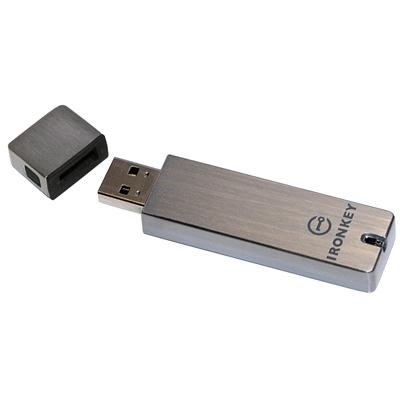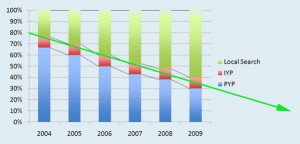Archive for the ‘Search’ Category.
13th November 2007, 07:37 pm
Today’s search engines do a good job organizing the billions of web pages published on the Internet. However, they are limited to the a single algorithm used for every user of their system. And the order in which search engines provide information is mostly determined by ‘popular vote’ (how many links point to a page). This creates a system in which the most popular seemingly equates to the most relevant result, while ignoring other valueable factors, such as source, timeliness and most of all user specific criteria. All of which currently do not – or barely – find a way into data organization by search engines.
The most important criteria of any (Internet (Re-)) Search however is the user and his or her knowledge, history, preferences and any other criteria inherent in any human being. What is called for therefore is not an adaption of search to the masses but an adaption of a search tool to its user.
Search engines will hardly be able to deliver that level of sophistication needed to fulfill these criteria. A paradigm shift is needed. This new paradigm could be in form of FinderAgents which could become the electronic representation of a user fulfilling his request (searches) and his/her behalf with his/her knowledge, preferences and anything else the user would like it to consider.
IÂ had the intention of calling this new system ‘user agents’ but unfortunately this term is being used for a lot of things that are really not related to what I envision. So for the time being I will call it Agratar as a word play of Avatar, a users (graphical) representation in the online world.
Work in progress ..
Category:
Search |
Comments Off on When Search Engines are gone: FinderAgents
25th October 2007, 12:08 pm
800 numbers not only make your work-at-home business look bigger but 800 number also increase the number of people willing to pick up the phone to call you and buy your goods and services from you.
Work at Home 800 Numbers.
For a great Work-At-Home 800 Number solution click here!
From 1967 to the AT&T breakup in 1984, AT&T had an absolute monopoly on assigning 800 numbers to subscribing customers. Billing during that period was based on average hours usage per line per month. This type of billing required users to adjust their active lines based on actual peak hour usage to avoid buying hours at higher low tier rates. Usage would average 13-15 cents per minute depending on the traffic being billed.
From 1984 to 1993 Toll-Free customers were locked into a system that wed them to the telephone carrier like AT&T or MCI that assigned them their 800 number. To increase competition, the FCC, in 1991, ordered the implementation of 800-number portability by May 1, 1993.[citation needed] 800 Number Portability means that toll-free numbers are not associated with a particular telephone carrier such as AT&T or MCI. 800 subscribers can switch to another carrier without changing their toll-free number. Before toll-free number portability, toll-free subscribers were locked into their carriers. They could not change those carriers without changing their 800 numbers. Starting in the early 90s, Toll-Free 800 Service became a viable business tool with the use on Vanity Numbers such as 1-800-FLOWERS. With these changes rates have continued to fall and the majority of large users are now buying toll free services for less than 2 cents per minute. Toll Free has become so popular that 800 is no longer the only toll free area code. Area codes 866, 877, 888 were all added to meet the increased demands of the end users.
Category:
Search |
Comments Off on Work at Home 800 Numbers
18th September 2007, 07:34 pm
 An IronKey looks like a typical USB flash drive but has shiny metal casing. It is waterproof and filled with a non-conductive rosin to make it impossible to open. This makes the drive a little heavier than a typical USB drive. Data stored on the IronKey is written to the flash memory in encrypted form by a microprocessor onboard the device itself. There’s no software installed in your computer to make it work, and it works the same way on all platforms. Furthermore, the IronKey uses AES, a very strong form of encryption that will keep everybody including the NSA out of your data.
An IronKey looks like a typical USB flash drive but has shiny metal casing. It is waterproof and filled with a non-conductive rosin to make it impossible to open. This makes the drive a little heavier than a typical USB drive. Data stored on the IronKey is written to the flash memory in encrypted form by a microprocessor onboard the device itself. There’s no software installed in your computer to make it work, and it works the same way on all platforms. Furthermore, the IronKey uses AES, a very strong form of encryption that will keep everybody including the NSA out of your data.
When you mount it, two new devices show up: What appears to be a CD-ROM drive and an empty removable media drive.
Using the drive is as simple as opening the CD-ROM partition, running the IronKey application, and providing your password. The encrypted partition will then mount as if it were a regular USB flash drive.When you first use the IronKey, you have to provide a password and initialize the key during which time the encryption keys are generated. IronKey uses AES encryption. Initializing takes about 30 seconds and can only be performed in Windows at the time of this writing.
When the IronKey is locked, the drive appears as if it were ejected—the drive letter appears but the computer will tell you to insert a disk.
Also included is a secure backup utility that makes a copy of your data in encrypted form on your PC’s hard disk. The data cannot be accessed unless you restore it to an IronKey, so the backup is safe from prying eyes. The backup utility provides peace of mind that losing the key doesn’t mean losing your files.
IronKey includes portable Firefox. This version of Firefox stores all its data on the USB flash drive, therefore leaving no trace of your browsing on the computer that you use.
Security
IronKey encrypts data with an onboard processor implementing AES encryption with an xxx bit keylength. The crypto keys are stored on the device in a special portion of memory that cannot be read via USB—it can only be unlocked and read by the onboard processor. Unlocking the key storage is performed through a challenge/response mechanism to prevent the secret password from being transmitted via USB.
I strongly recommend the IronKey for anyone using a Laptop or who has a prefers to carry private, classified, sensitive, or secret information.
Category:
Search |
Comments Off on Labtop Security
15th August 2007, 03:56 pm
The improvement of search engine algorithm and the appearance of local portals caused a steady and drastic traffic decline for online yellow page services. Since the beginning of 2006 pure yellow pages like the SuperPages (superpages.com), YellowPages (yellowpages.com), Local.com and Yellow.com lost 50% and more traffic volume. None of the online yellow page providers play a significant role among the leading web sites, as they combined reach less than 0.1% of Internet users.

Category:
Search |
Comments Off on The Decline of the Yellow Pages
18th July 2007, 11:00 am
 My vision for the Internet is a bot readable structure (Semantic Web) filled with reliable information.
My vision for the Internet is a bot readable structure (Semantic Web) filled with reliable information.
Radiux is one step in this direction. Whereas thousands of online directories let anybody with a free email account create entries, Radiux only allows businesses that are willing to verify their entry through a valid, unique US phone number.
If all information – maybe with the exception of public discussion boards – required the user to REALLY identify themselves the Internet might be smaller but probably a much more reliable resource of information.
Category:
Search |
Comments Off on Sweeping the Internet
 An IronKey looks like a typical USB flash drive but has shiny metal casing. It is waterproof and filled with a non-conductive rosin to make it impossible to open. This makes the drive a little heavier than a typical USB drive. Data stored on the IronKey is written to the flash memory in encrypted form by a microprocessor onboard the device itself. There’s no software installed in your computer to make it work, and it works the same way on all platforms. Furthermore, the IronKey uses AES, a very strong form of encryption that will keep everybody including the NSA out of your data.
An IronKey looks like a typical USB flash drive but has shiny metal casing. It is waterproof and filled with a non-conductive rosin to make it impossible to open. This makes the drive a little heavier than a typical USB drive. Data stored on the IronKey is written to the flash memory in encrypted form by a microprocessor onboard the device itself. There’s no software installed in your computer to make it work, and it works the same way on all platforms. Furthermore, the IronKey uses AES, a very strong form of encryption that will keep everybody including the NSA out of your data.
 My vision for the Internet is a bot readable structure (
My vision for the Internet is a bot readable structure (



